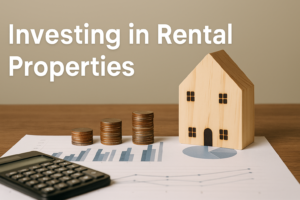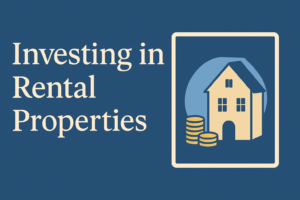How to Start Investing in Rental Properties: A Complete Guide for U.S. Investors
Real estate has long been regarded as one of the most stable and profitable investments. Among the various strategies available, investing in rental properties remains a favorite for building long-term wealth and generating passive income. If you’re considering diving into the U.S. rental market, this guide will walk you through everything you need to know—from understanding the basics to making your first property purchase.
market, this guide will walk you through everything you need to know—from understanding the basics to making your first property purchase.
Why Invest in Rental Properties?
Rental property investment offers several compelling benefits:
Steady Cash Flow: Tenants provide monthly income.
Appreciation: Properties often increase in value over time.
Tax Benefits: Deductions on mortgage interest, property taxes, depreciation, and repairs.
Leverage: Use financing to purchase property and multiply returns.
Control: Unlike stocks, you have direct control over the asset.
According to a 2023 National Association of Realtors (NAR) report, rental housing demand continues to rise due to inflation, population growth, and limited housing supply—making this a prime time to invest.
Types of Rental Properties
Before investing, it’s important to understand your options:
1. Single-Family Homes (SFHs)
.Easier to manage
.Lower entry cost
.Attract long-term tenants
2. Multi-Family Properties (Duplexes, Triplexes, Quads)
.Multiple rental incomes
.Economies of scale in maintenance
.Higher upfront investment
3. Vacation Rentals (Short-Term)
.Potentially higher income
.Seasonal demand fluctuations
.Requires active management
4. Turnkey Properties
.Ready-to-rent properties, often managed by third parties
.Great for out-of-state investors
.Typically priced at a premium
Steps to Start Investing in Rental Properties
Step 1: Set Your Investment Goals
.Are you looking for monthly cash flow, appreciation, or both?
.Do you want to be hands-on or prefer a property manager?
.What is your risk tolerance and time horizon?
Step 2: Understand Your Finances
.Check your credit score (ideally 680+)
.Determine your budget and financing options
.Save for a down payment (typically 15-25%) and closing costs
Step 3: Research the Right Market
.Focus on cities with:
.Job growth and population increases
.Affordable property prices relative to rent
.Low vacancy rates
.Landlord-friendly laws
Top U.S. Rental Markets in 2025:
.Charlotte, NC
.Tampa, FL
.Austin, TX
.Indianapolis, IN
.Atlanta, GA
Step 4: Analyze Rental Property Deals
Use the 1% Rule and Cash-on-Cash Return:
.1% Rule: Monthly rent should be at least 1% of the property price
.Cash-on-Cash Return: (Annual Cash Flow / Initial Cash Investment) × 100
Step 5: Secure Financing
Options include:
.Conventional Loans
.FHA Loans (for multi-family with owner-occupancy)
.Private Lenders or Hard Money Loans
.Real Estate Partnerships
Tip: Get pre-approved before starting your search.
Step 6: Make the Purchase
.Work with an experienced real estate agent
.Conduct due diligence and property inspections
.Negotiate and close the deal
Step 7: Prepare the Property
.Perform necessary repairs or upgrades
.Ensure it complies with local building codes
.Set a competitive rent based on market comps
Step 8: Find Quality Tenants
.Screen tenants for credit, background, and income
.Use a standard lease agreement
.Collect security deposits and perform move-in inspections
Step 9: Manage the Property
You can:
.Self-manage (time-intensive)
.Hire a property management company (8-12% of monthly rent)
Step 10: Track and Optimize Your Investment
.Use tools like Stessa or Buildium for financial tracking
.Reinvest profits to grow your portfolio
Real-Life Example: $200K Property in Indianapolis, IN
Purchase Price: $200,000
Down Payment (20%): $40,000
Monthly Rent: $2,000
Mortgage + Expenses: $1,300
Cash Flow: $700/month or $8,400/year
Cash-on-Cash Return: 21%
Common Risks and How to Avoid Them
.Vacancies: Mitigate with strong screening and desirable locations
.Maintenance Costs: Budget 10-15% of rent for repairs
.Bad Tenants: Use thorough screening and legal support
Market Downturns: Invest in stable markets with long-term growth
Tax Benefits of Rental Property Investment
.Depreciation Deductions
.Mortgage Interest Deductions
.Operating Expense Deductions
.1031 Exchanges for deferring capital gains
Always consult a real estate CPA to maximize deductions.
DIY vs. Passive Investing
DIY Investing:
.Full control
.Greater returns potential
.More time and effort
Passive Investing:
.Invest via platforms like Roofstock or Fundrise
.Less hands-on
.Lower, but stable returns
FAQs About Rental Property Investing
Q: Is investing in rental properties still profitable in 2025?
A: Yes. Despite interest rate hikes, rents remain high and housing inventory low.
Q: How much money do I need to start?
A: At least 15-25% of the property price, plus reserves for expenses.
Q: Should I form an LLC for my rental property?
A: An LLC can offer liability protection but has tax and setup implications. Consult a lawyer.
Final Thoughts
Investing in rental properties can be a powerful wealth-building strategy if done right. By understanding the market, running the numbers, and taking a strategic approach, you can generate passive income and long-term growth.
—
Ready to Begin Your Real Estate Investment Journey?
Explore our curated rental property listings or contact our expert team at USPropertyInsider.com for personalized guidance and resources. Let us help you make smart, profitable investment decisions today.